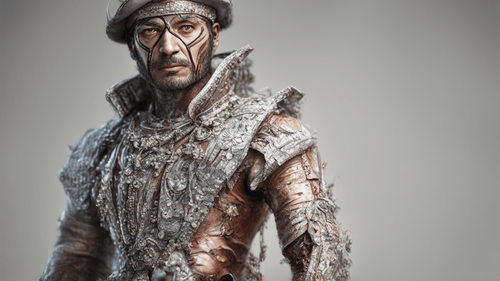
Art has always been a profound expression of human creativity, capturing emotions, stories, and beauty through visuals. With the advent of Artificial Intelligence (AI), the world of art has witnessed a transformative shift. AI art image generation, a groundbreaking fusion of technology and creativity, is redefining the boundaries of what is possible in the realm of artistic expression. In this article, we delve into the captivating universe of AI-generated art images, their significance, and how Picasso AI is leading this revolutionary movement.
AI Art Image: Where Technology Meets Imagination
Understanding AI's Role in Artistic Creation
AI, or Artificial Intelligence, refers to the simulation of human intelligence processes by machines, primarily computer systems. It encompasses machine learning, neural networks, and deep learning algorithms that empower machines to analyze data, learn patterns, and generate outputs that mimic human thinking. In the context of art, AI serves as a virtual collaborator, augmenting the artist's creativity by generating images, styles, and even ideas.
The Rise of AI-Generated Art
The emergence of AI-generated art is a testament to the convergence of technology and artistic expression. Artists, programmers, and researchers have joined forces to develop algorithms that can produce visuals that challenge traditional definitions of creativity. From abstract compositions to hyper-realistic portraits, AI algorithms have the potential to push the boundaries of visual aesthetics.
AI Art's Impact on Human Creativity
Rather than replacing human artists, AI art image generation enhances the creative process. By analyzing vast amounts of artistic data, AI algorithms can provide artists with fresh perspectives, inspiring them to explore new styles, techniques, and subjects. This collaboration between human ingenuity and AI's analytical capabilities opens doors to uncharted artistic territories.
Picasso AI: Illuminating the Artistic Landscape
Revolutionizing Artistic Creation
At the forefront of the AI art image movement is Picasso AI, an innovative platform that empowers artists with AI-generated content. Leveraging advanced algorithms, Picasso AI assists artists in generating captivating visual elements that can be seamlessly integrated into their works. This revolutionary tool is not just a mere generator; it's a catalyst for new artistic visions.
Unleashing Creative Possibilities
Picasso AI's technology is rooted in deep learning and neural networks, enabling it to analyze artistic styles, composition techniques, and historical references. Through this analysis, it assists artists in creating pieces that are both imaginative and informed, bridging the gap between tradition and innovation.
AI as a Collaborative Partner
One of the remarkable aspects of Picasso AI is its role as a collaborative partner. Artists can interact with the platform, guiding the AI's output to align with their creative intent. This dynamic partnership fuels a reciprocal exchange, where AI-driven suggestions inspire artists, and artists, in turn, guide the AI towards refining its output.
The Creative Journey: From Canvas to Code
The Artistic Process Enhanced by AI
The creative journey, whether for a seasoned artist or a budding enthusiast, is often marked by challenges and breakthroughs. AI art image generation introduces a new dimension to this journey. As artists experiment with AI-generated elements, they embark on a process of exploration and discovery, uncovering novel possibilities that spark their artistic evolution.
Hybrid Creations: Marrying Tradition and Innovation
AI-generated art doesn't exist in isolation; it seamlessly blends with traditional artistic elements. Artists can incorporate AI-generated imagery into their works, juxtaposing classic techniques with modern interpretations. This fusion results in captivating pieces that resonate with both heritage and contemporary aesthetics.
AI Art Image: Answering FAQs
How Does AI Generate Art Images?
AI generates art images by processing vast datasets of existing artworks, learning patterns, styles, and composition techniques. It then uses this knowledge to create new visuals that reflect a fusion of learned elements.
Can AI Replace Human Artists?
No, AI cannot replace human artists. Instead, AI serves as a tool that enhances artistic creativity and provides fresh perspectives. The essence of art lies in human emotions, experiences, and intentions, which AI cannot replicate.
Is AI Art Authentic?
AI art is authentic in the sense that it's generated by AI algorithms using learned techniques. However, debates around authenticity stem from the role of human creativity and intention in the artistic process.
Does AI Art Undermine Traditional Techniques?
AI art doesn't undermine traditional techniques; instead, it complements them. Artists can use AI-generated elements to experiment with new ideas while staying rooted in traditional craftsmanship.
What Makes Picasso AI Unique?
Picasso AI stands out for its dynamic collaboration between artists and AI algorithms. It's a tool that empowers artists to explore uncharted territories while retaining their creative control and vision.
Are AI-Generated Artworks Valuable?
AI-generated artworks hold value in the art community. Their uniqueness lies in the fusion of AI's analytical capabilities and human creativity, making them intriguing additions to the art landscape.
Conclusion: A Harmonious Symphony of Creativity
The intersection of AI and art has given rise to an era of unprecedented creativity. AI art image generation is not about replacing human artists but about enriching their creative palette. Picasso AI exemplifies this harmonious partnership, where technology and imagination coalesce to create breathtaking art. As artists and audiences alike continue to explore the vast realm of AI-generated art, one thing is clear: the future of creativity is an enchanting fusion of human emotion and artificial intelligence.
Explore the possibilities. Embrace the collaboration. Witness the evolution of art through the lens of AI art image generation—a journey that sparks creativity, challenges conventions, and reshapes the artistic narrative.
(Word Count: 1000)